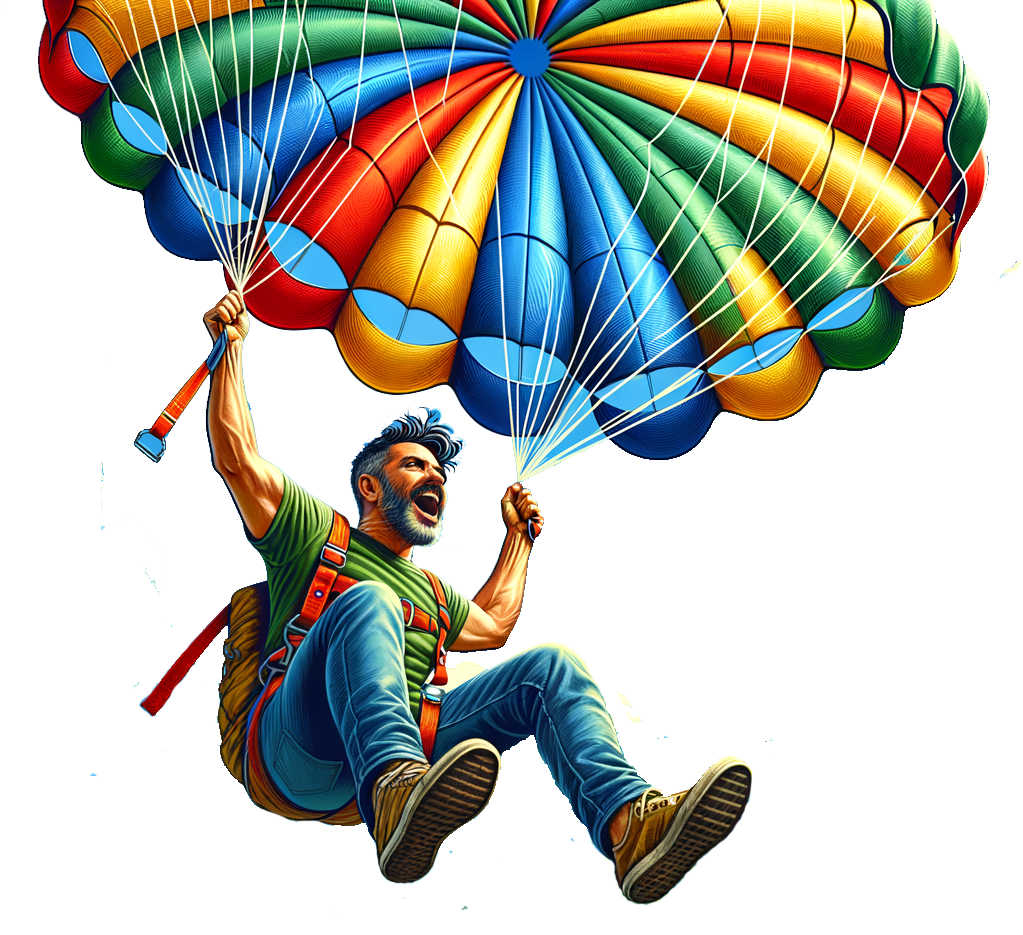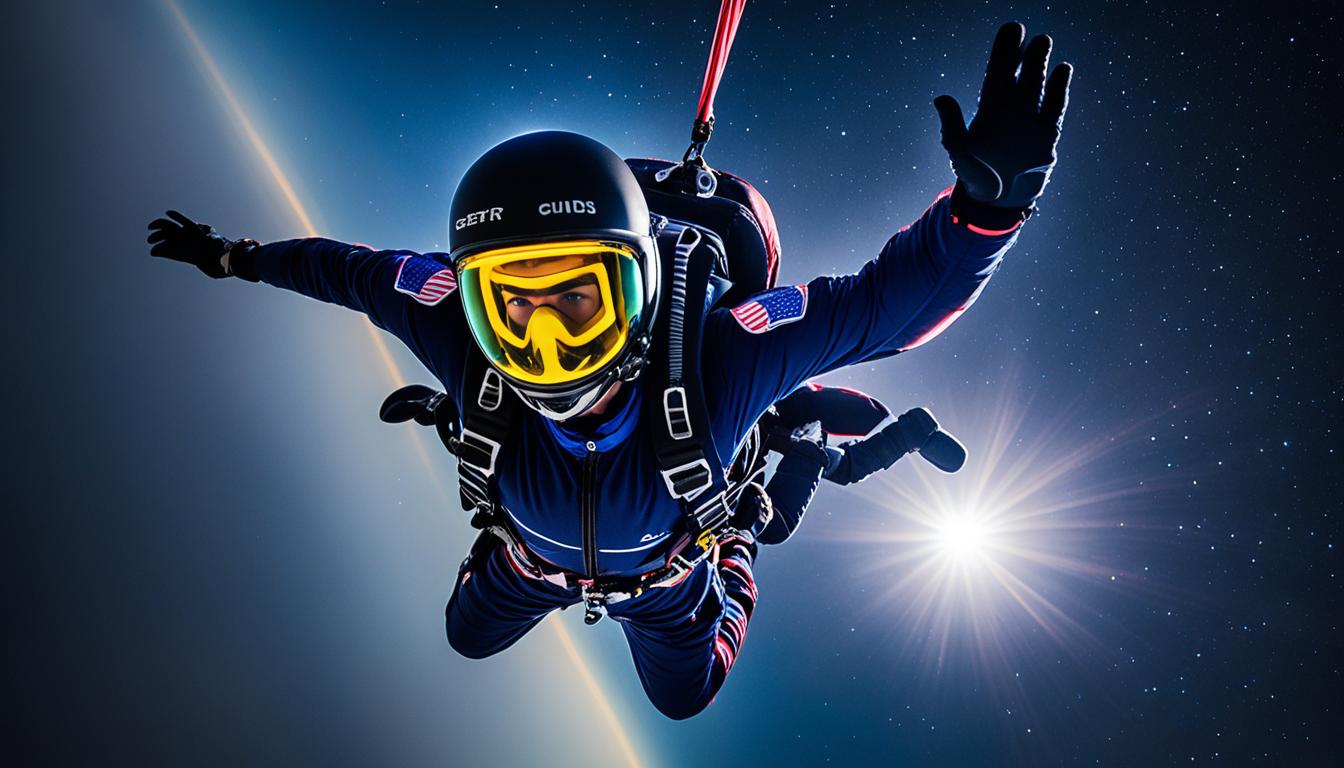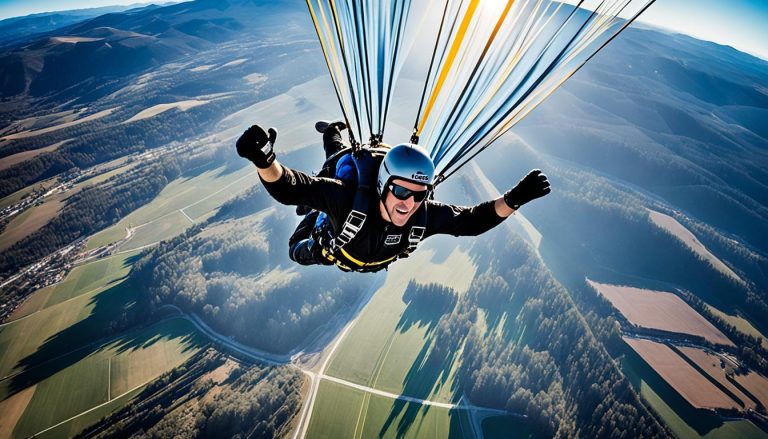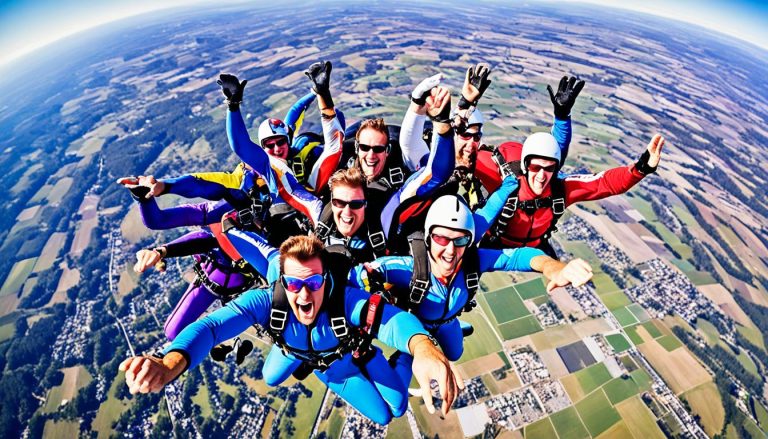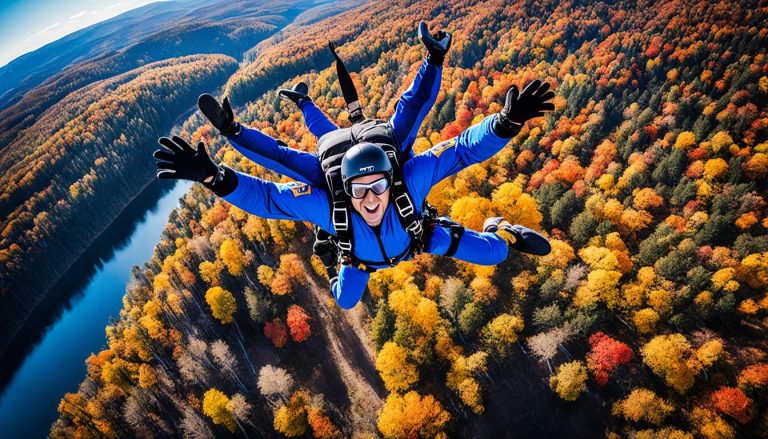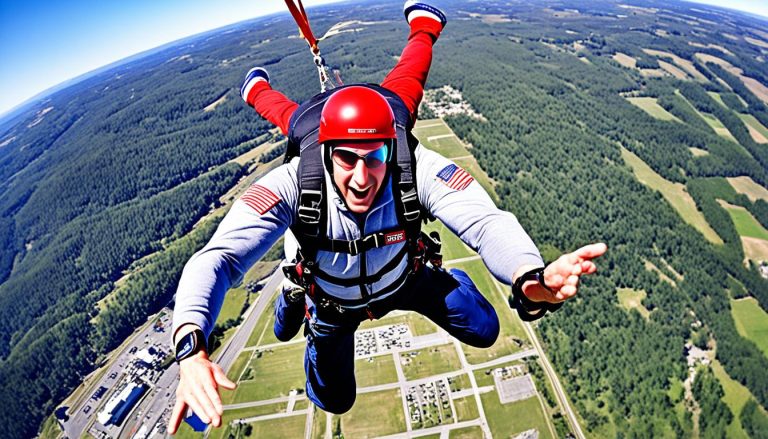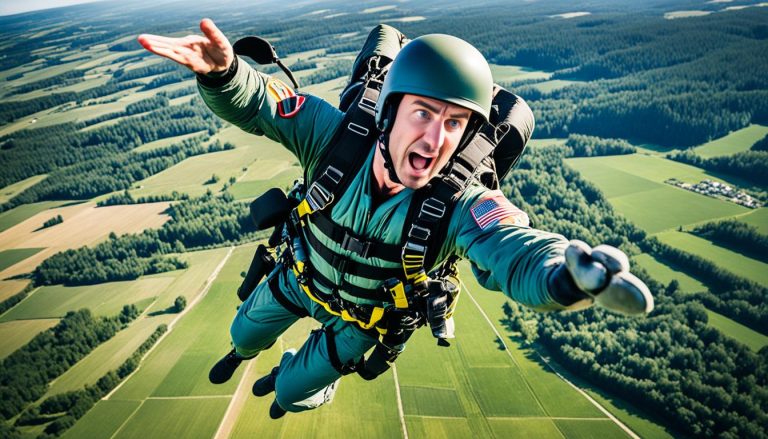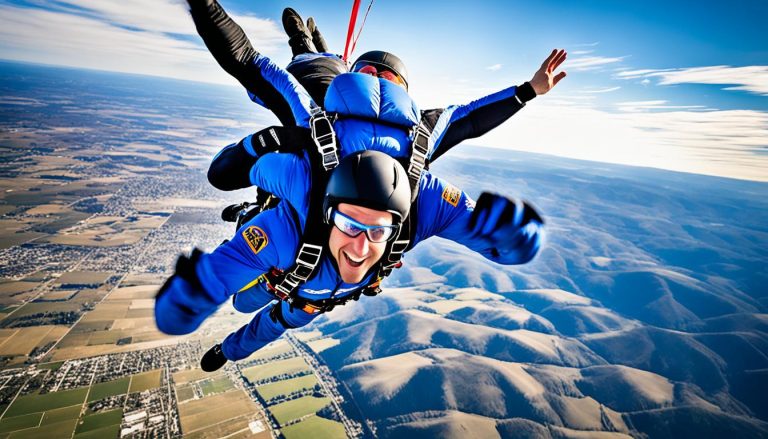Special considerations and techniques while Parachuting at night
Parachuting at night presents a unique set of challenges and requires special considerations to ensure safety and a successful experience. Whether you are an experienced skydiver or a novice, it is essential to understand the precautions, gear, and techniques involved in night skydiving.
Night skydiving safety is of paramount importance. The reduced visibility associated with parachuting at night demands a heightened level of awareness and preparation. Implementing appropriate night jump precautions can help mitigate risks and ensure a smooth and thrilling experience.
When it comes to night skydiving gear, specialized equipment is necessary. An illuminated altimeter becomes a lifeline, providing accurate altitude information in low light conditions. Clear goggles enhance vision, allowing skydivers to navigate the night sky with clarity. Chem lights, strobe lights, and whistles aid visibility and communication between jumpers during freefall and under the parachute.
Mastering specific night parachuting techniques is crucial for a successful jump. Skydivers must understand landing considerations, such as the challenges of reduced visibility and altered depth perception. Drop zones ensure the landing area is illuminated, often by using car headlights positioned strategically. However, even with these measures, night jump visibility remains a factor that requires careful attention.
Parachuting at night offers a thrilling adventure for those seeking a unique and exhilarating experience. By following safety protocols, being well-equipped, and employing the right techniques, night skydiving can be a memorable and rewarding activity. So, if you’re ready to soar through the night sky and push your limits, consider the exciting world of nighttime skydiving.
Tandem Skydiving and Night Jumps
Tandem skydiving at night is an exhilarating experience that combines the thrill of skydiving with the excitement of nighttime adventure. However, due to safety concerns and limitations, tandem skydiving is currently not allowed at night in the United States.
Night skydiving poses additional risks compared to daytime jumps. The limited field of vision makes it challenging for instructors and tandems to safely navigate the sky. Tandem skydiving businesses prioritize risk mitigation and adhere to strict safety protocols to ensure the well-being of participants.
Individuals interested in night jumps must meet specific requirements to ensure their readiness and safety. This includes possessing a USPA “B” license or higher, which demonstrates a certain level of expertise and experience in skydiving. Additionally, individuals must undergo a comprehensive night briefing to familiarize themselves with the unique challenges and safety precautions associated with night jumps.
The limitations on tandem skydiving at night are in place to prioritize the safety of all participants. By focusing on the individual skill development and qualifications necessary for night jumps, tandem skydiving businesses can ensure a safe and enjoyable experience for everyone involved.
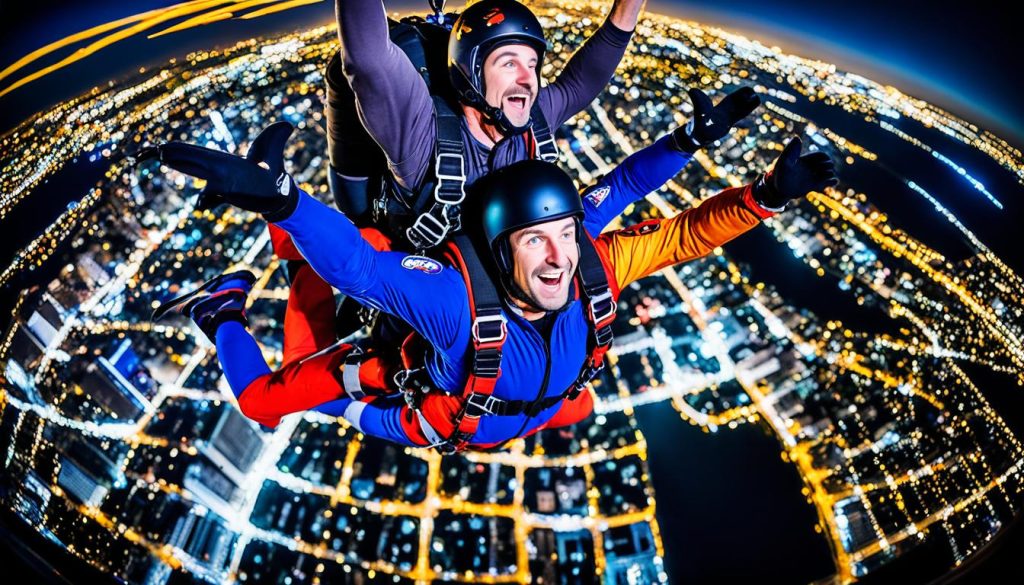
Tandem skydiving at night may currently be limited, but it doesn’t diminish the excitement and adventure that a night jump can offer. As an alternative, solo licensed skydivers can embrace the challenge of night jumps, allowing them to experience the thrill of soaring through the darkened skies while ensuring their safety and maintaining the integrity of the sport.
Specialized Night Jumping Equipment
Night skydiving requires specialized equipment to enhance visibility and safety. Skydivers must have:
- An illuminated altimeter: The altimeter is a crucial instrument that helps skydivers track their altitude during the jump. In low-light conditions, an altimeter with a lighted or phosphorescent face is essential for easy readability.
- Clear goggles: Clear goggles are essential for night skydiving, as they provide enhanced vision and protect the eyes from wind, debris, and potential hazards. With clear goggles, skydivers can maintain a clear line of sight and navigate with greater confidence.
- Chem lights: Chem lights are small, lightweight sources of illumination that can be attached to various parts of the skydiver’s gear. These lights help increase visibility in the night sky, making it easier for other jumpers to locate and track each other during freefall and under the parachute.
- A strobe light: A strobe light is another valuable piece of equipment for night jumps. The strobe light improves jumper-to-jumper visibility, especially during freefall and under the canopy. Its intermittent flashes of bright light make skydivers more conspicuous to others in the sky.
- A whistle: Each individual skydiver is equipped with a whistle to enhance communication while under the parachute. The whistle aids in relaying important information to other jumpers and can act as an emergency signaling device if needed.
These specialized gear and equipment play a crucial role in aiding skydivers to navigate the night sky and ensuring a safer experience. Their purpose is to enhance visibility, promote communication, and mitigate potential risks associated with night skydiving.
Landing Considerations at Night
Landing during a night jump requires special considerations. Drop zones make arrangements to light the landing area using a teamwork approach, such as lining up cars with headlights. Despite these measures, the landing area may still be challenging to see from full altitude.
Night skydiving presents unique challenges, including reduced visibility and altered depth perception. Experienced jumpers recognize the heightened level of risk and embrace it as an opportunity for personal growth and overcoming fear.
While nighttime skydiving can be scary, it offers a thrilling adventure for individuals seeking a unique and challenging experience.
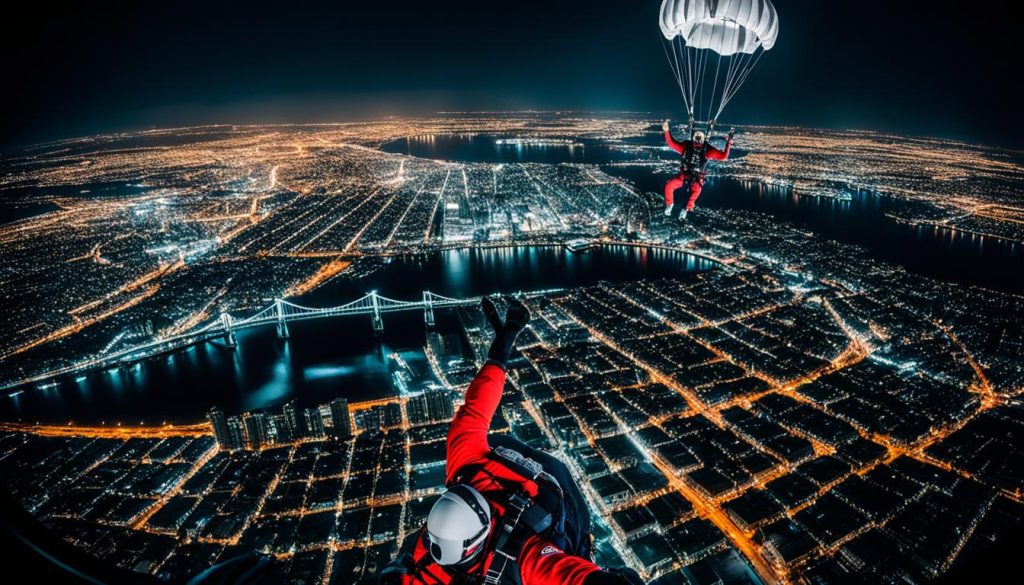
During a night jump, the visibility can be significantly limited, making it essential to have an illuminated landing area. Drop zones employ a teamwork approach to ensure the landing area is well-lit. Car headlights are often used to light up the landing zone, providing jumpers with a clearer view of their target.
The challenges of night skydiving extend beyond the reduced visibility. Altered depth perception under the cover of darkness can be disorienting, requiring jumpers to rely more on their instincts and spatial awareness.
Experienced skydivers understand the unique demands of night jumps and approach them with caution and a deep sense of responsibility. They value the opportunity for personal growth and the thrill of conquering the challenges associated with night skydiving.
Conclusion
Parachuting at night requires special considerations and techniques to ensure a safe and thrilling experience. Night jumps, made one hour after official sunset to one hour before official sunrise, offer an opportunity for experienced skydivers to push personal limits and conquer fears. To engage in this adventure, skydivers must possess specific certifications, such as a USPA “B” license or higher, and utilize specialized equipment like lighted altimeters and chem lights to enhance visibility.
Despite the challenges presented by reduced visibility and altered perceptions, experienced jumpers embrace nighttime skydiving as an exhilarating adventure. Soaring through the night sky not only provides a unique perspective but also offers a sense of accomplishment and personal growth. The thrill of nighttime skydiving comes from navigating the darkness, relying on safety protocols, and pushing oneself beyond comfort zones.
Nighttime skydiving is an extraordinary experience that requires meticulous planning, teamwork, and adherence to safety guidelines. By following established protocols and utilizing specialized equipment, skydivers can enjoy the mesmerizing beauty of the night sky while ensuring their safety. Whether it’s the adrenaline rush, the challenge, or the allure of the night, nighttime skydiving promises an unforgettable adventure that pushes the boundaries of what’s possible in the world of skydiving.
